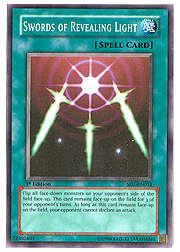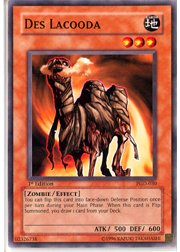
It’s hard for me to not support aggro as the best archetype to build a deck around in the current advanced format. After all, it is a lot easier to base a deck strategy on defeating your opponent quickly and effectively rather than waiting until you are in a situation where you are almost sure not to lose. That’s because a deck based off of an aggressive strategy is meant to be a pro-active deck. You defeat your opponent by playing out your game faster than the opponent can play out his or hers.
Of course, this isn’t to say that control decks aren’t good right now. They are simply harder to run, and more vulnerable to the surprise factor at a regional event or a Shonen Jump Championship. However, despite how different some decks can be, those surprise factor decks that can wreck a control strategy will usually try to beat you through battle. Their only other option is through some degenerate combo . . . something along the lines of Vincent Tundo’s Life Equalizer deck from U.S Nationals this year.
This is what makes Nightmare’s Steelcage one of the best control cards right now, with the advanced format still developing.
 Some players might not be familiar with Nightmare’s Steelcage. Its release was pretty quiet, since it was one of the new cards released in the Spellcaster’s Judgment Structure Deck. The effect is reminiscent of Swords of Revealing Light, though Nightmare’s Steelcage is much more restrictive. This doesn’t make it bad, however. Swords of Revealing Light is still one of the most powerful spell cards to ever be released, thanks to its ability to freeze any serious action for three full turns. Nightmare’s Steelcage is an unlimited version of Swords of Revealing Light, and you only sacrifice an extra turn of stall and your own ability to attack to get a similar effect!
Some players might not be familiar with Nightmare’s Steelcage. Its release was pretty quiet, since it was one of the new cards released in the Spellcaster’s Judgment Structure Deck. The effect is reminiscent of Swords of Revealing Light, though Nightmare’s Steelcage is much more restrictive. This doesn’t make it bad, however. Swords of Revealing Light is still one of the most powerful spell cards to ever be released, thanks to its ability to freeze any serious action for three full turns. Nightmare’s Steelcage is an unlimited version of Swords of Revealing Light, and you only sacrifice an extra turn of stall and your own ability to attack to get a similar effect!
The ability to control when your opponent can attack is probably the most powerful control ability in . . . well, any trading card game. A control deck’s goal is to stabilize against an opponent’s threats, and then win with its own threats later in a duel, when the control player has little chance to lose. Hence, a control deck reacts to your opponent’s attempts to win until you have complete “control” over the duel and can win without any risk of your opponent drawing out of his or her bad situation. A player can use many different cards and abilities to gain control of the later game. Usually, these decks feature cards that can each negate several of the opponent’s cards, preventing him or her from winning. Nightmare’s Steelcage is one such card that can stop the opponent dead in his or her tracks.
Stall cards such as this have seen plenty of play in the Yu-Gi-Oh! TCG, and they have been very, very powerful. Swords of Revealing Light was originally a semi-limited card, but was limited to one shortly after the game’s release because some players realized that running three copies of Magician of Faith and two copies of Swords of Revealing Light meant a lot of turns where you had all the time in the world to win your duel. Spell Ruler introduced an unlimited continuous spell known as Messenger of Peace, but with smaller monsters such as Mystic Tomato and Masked Sorcerer still having the ability to attack under it, its power was far from impressive at times. Gravity Bind changed that, and the continuous trap card released in Pharaoh’s Servant was quickly semi-limited (and eventually hit the “one per deck” list with the latest changes to the advanced and traditional formats). Level Limit - Area B met the same treatment six months earlier, with its ability to foil most tournament-caliber monsters and their attacks, and its safety from trap-hating cards such as Jinzo and Royal Decree.
The combo of a Sheep Token and Metamorphosis generated one of the most powerful stall engines ever created: Thousand-Eyes Restrict. While it is probably my favorite fusion monster, the old trump-card of Pegasus from the Yu-Gi-Oh! TV series proved too good even as a fusion and it has been forbidden from tournament play since September of this year. Nightmare’s Steelcage has had some tough competition since its release, so it is understandable that it hasn’t seen so much play.
 Nightmare’s Steelcage has received a little bit of hype from players who supported the short-lived P.A.C.M.A.N. control deck*, but other than that, the spell card has gone unnoticed. However, many of the more powerful stall elements in the game are limited or forbidden from play now. Nightmare’s Steelcage steps up as the next best choice for those who prefer ignoring the battle phase to attacking. While some players dwell on the fact that you effectively lose a card with both Nightmare’s Steelcage and Swords of Revealing Light, you are getting something far more valuable than cards in return. Nightmare’s Steelcage gives you turns. In exchange for one spell card, you get two free turns of inactivity from your opponent, during which you can draw more stall cards or perhaps a win condition. This also gives you the time to set up monsters such as Des Lacooda and Stealth Bird, which, in exchange for the free turns, will give you even more options. The ability to completely destroy any form of tempo your opponent can establish is very powerful.
Nightmare’s Steelcage has received a little bit of hype from players who supported the short-lived P.A.C.M.A.N. control deck*, but other than that, the spell card has gone unnoticed. However, many of the more powerful stall elements in the game are limited or forbidden from play now. Nightmare’s Steelcage steps up as the next best choice for those who prefer ignoring the battle phase to attacking. While some players dwell on the fact that you effectively lose a card with both Nightmare’s Steelcage and Swords of Revealing Light, you are getting something far more valuable than cards in return. Nightmare’s Steelcage gives you turns. In exchange for one spell card, you get two free turns of inactivity from your opponent, during which you can draw more stall cards or perhaps a win condition. This also gives you the time to set up monsters such as Des Lacooda and Stealth Bird, which, in exchange for the free turns, will give you even more options. The ability to completely destroy any form of tempo your opponent can establish is very powerful.
Nightmare’s Steelcage can definitely warrant play in today’s advanced format. Some players tend to forget this, but tempo is one of the most important aspects of playing Yu-Gi-Oh! TCG. Nightmare’s Steelcage, like many cards before it, completely denies your opponent any tempo unless he or she is willing to sacrifice some spell or trap removal to get in an attack or two. If the card remains on the field for its full two turns, you will have extra time to set up slow, powerful cards like Des Lacooda or Wave-Motion Cannon. When you have two extra turns to find other cards or to win the game by means other than battle, you will begin to realize how important this spell card really is.
If you have any questions or comments regarding this or any previous articles of mine, feel free to e-mail me at Mrosenberg@metagame.com.
*P.A.C.M.A.N. was a control deck based off of stall abilities and self-flipping monsters such as Des Lacooda to generate card advantage. Despite internet hype from supporters of the deck, it never took off because of one major flaw: the builds focus so much on “advantage” that they don’t actually effectively win the game. If you are looking for a deck to explore for this format, consider a stasis/control deck based on Des Lacooda, but make sure you plan on winning the game outside of the battle phase.